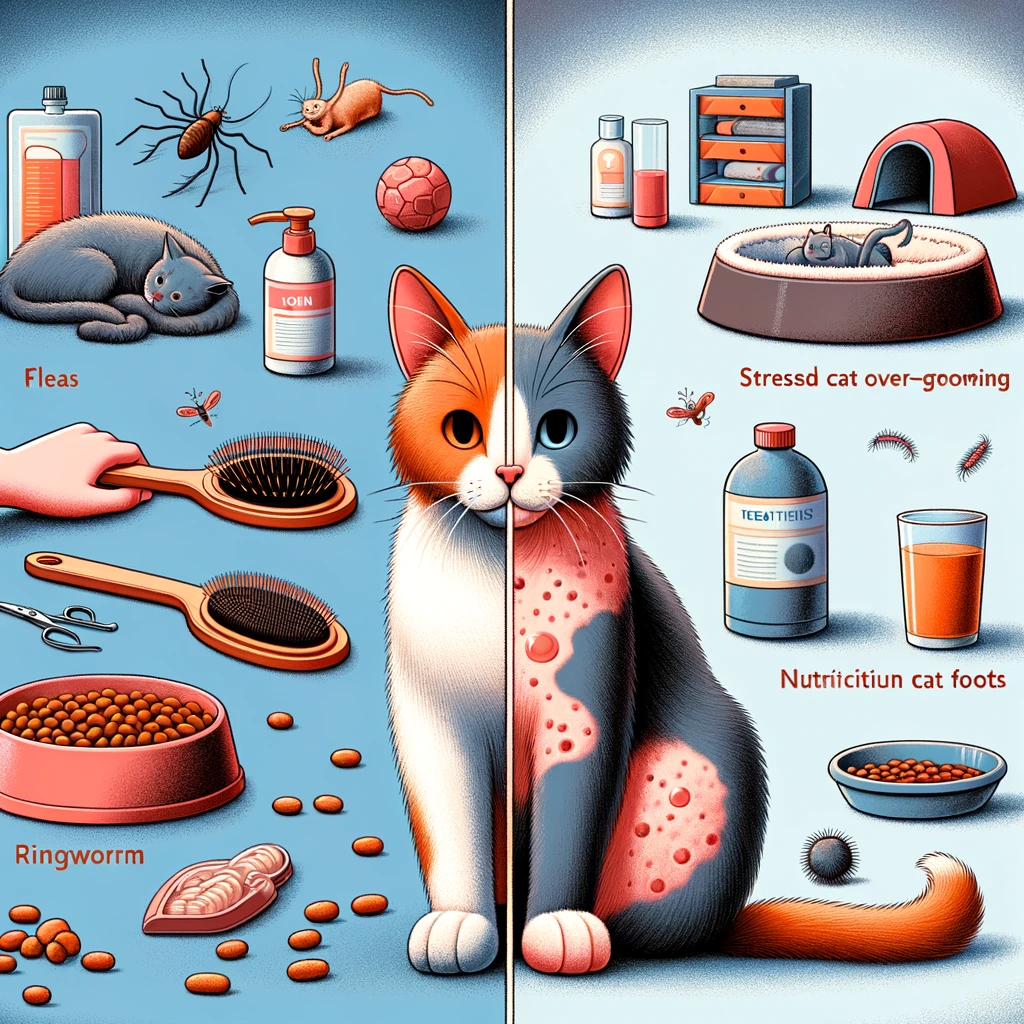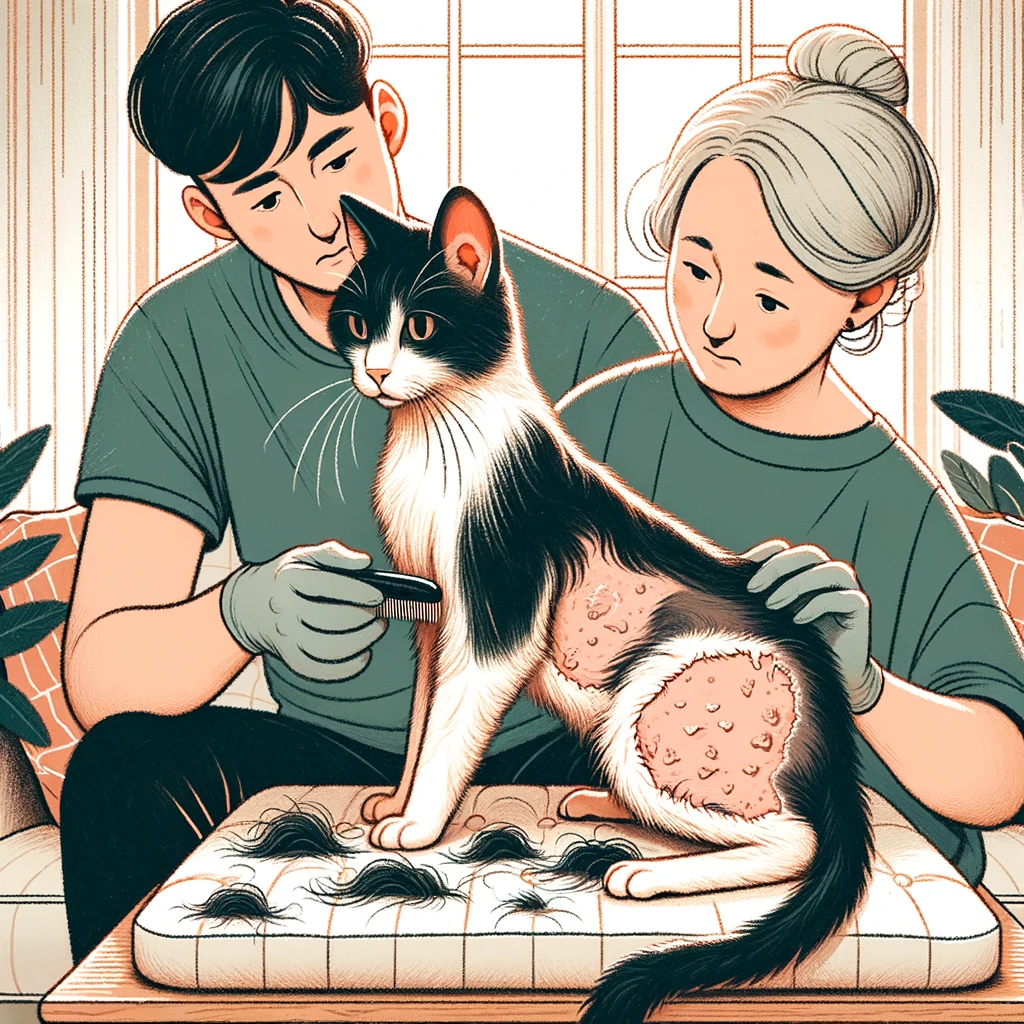Discovering that your cat’s hair is falling out can be alarming for any pet owner. Whether it’s hair falling out in clumps, patches, or your cat losing weight alongside hair loss, these symptoms can indicate a variety of health issues, some of which require immediate attention. This article will explore the common causes of feline hair loss, including why your cat might be losing hair on her belly, legs, and back, and discuss home treatment options and when to seek veterinary care.

Understanding Feline Hair Loss
Feline hair loss, or alopecia, can occur for many reasons, ranging from normal shedding to more serious health conditions. When a cat’s hair is falling out in clumps or patches, it’s a sign that something is amiss. Observing the pattern and location of the hair loss can provide clues to the underlying cause.
Common Reasons for Cat Hair Loss
- Allergies: Cats can develop allergies to food, fleas, or environmental irritants, leading to hair loss.
- Parasites: Fleas, ticks, and mites can cause itching and hair loss, especially if the cat is allergic.
- Fungal Infections: Ringworm, a common fungal infection in cats, often results in circular patches of hair loss.
- Bacterial Infections: Skin infections can lead to hair loss in affected areas.
- Hormonal Imbalances: Conditions like hyperthyroidism or Cushing’s disease can cause hair loss.
- Stress and Anxiety: Over-grooming due to stress can result in hair loss, particularly on the belly, legs, and sides.
- Nutritional Deficiencies: Poor diet lacking in essential nutrients can affect coat health.
- Genetic Conditions: Some breeds are prone to genetic conditions that can cause hair loss.
- Immune Disorders: Autoimmune diseases can target the skin and hair follicles, leading to hair loss.
- Physical Trauma: Injuries or surgeries can result in temporary hair loss around the affected area.
- Sunburn: Cats, especially those with thin or light-colored fur, can get sunburned, causing hair loss in exposed areas.
- Psychogenic Alopecia: A behavioral condition where cats excessively lick or chew their fur due to stress, leading to hair loss.
- Sebaceous Adenitis: A rare skin condition that affects the sebaceous glands, leading to hair loss and scaly skin.
- Feline Endocrine Alopecia: A hormonal condition causing symmetrical hair loss on the abdomen, inner thighs, and along the back.
- Feline Leukemia Virus (FeLV): FeLV can cause various health issues, including hair loss due to weakened immunity.
- Demodectic Mange: Caused by Demodex mites, leading to hair loss, but is less common in cats than dogs.
- Cheyletiellosis (Walking Dandruff): A mite infestation that causes scaling and hair loss, often along the back.
- Feline Acne: Can cause hair loss around the chin and lips where acne is present.
- Pressure Sores: Usually on elbows or other pressure points, leading to hair loss and sores.
- Seasonal Shedding: Normal but can be excessive if the cat’s health is compromised or if not groomed properly.

Why is My Cat Losing Hair on Her Belly and Legs?
Hair loss on a cat’s belly and legs can often be attributed to over-grooming, which itself can be triggered by stress, allergies, or skin irritation. Another possible reason is a condition called feline endocrine alopecia, which affects certain areas of the body and is linked to hormonal imbalances.

Feline Leukemia and Hair Loss
Feline leukemia is a viral disease that can suppress the immune system, leading to various secondary infections and conditions, including hair loss. If your cat has been diagnosed with feline leukemia and is experiencing significant hair loss, it’s crucial to follow up with your vet for a tailored treatment plan.
Home Treatment for Cat Hair Loss
While some causes of hair loss require veterinary treatment, there are home care steps you can take to improve your cat’s skin and coat health:
- Regular Grooming: Brush your cat regularly to remove dead hair and stimulate skin circulation.
- Balanced Diet: Ensure your cat’s diet is rich in omega-3 and omega-6 fatty acids, which promote healthy skin and coat.
- Hydration: Keep fresh water available at all times to help keep your cat’s skin hydrated.
- Flea Prevention: Use veterinarian-approved flea treatments to prevent parasites that can cause hair loss.
- Stress Reduction: Provide a calm environment, toys, and regular playtime to minimize stress-induced over-grooming.
- Avoid Allergens: Identify and reduce exposure to potential allergens, such as certain foods, pollen, or dust.
- Supplements: Consult your vet about supplements like fish oil that can improve skin and coat health.
- Skin Moisturizers: Use cat-specific skin moisturizers to treat dry skin, but only under vet guidance.
- Gentle Bathing: Bathe your cat with a mild, cat-specific shampoo if dirt or allergens are contributing to skin irritation.
- Monitor and Rotate Diets: If food allergies are suspected, work with your vet to identify the cause and adjust the diet accordingly.
- Environmental Enrichment: Provide scratching posts, perches, and hideaways to reduce boredom and stress.
- Clean Living Space: Regularly clean your cat’s bedding, toys, and living areas to reduce dust and potential allergens.
- Limit Sun Exposure: Protect cats with light skin or thin coats from excessive sun, which can lead to sunburn and hair loss.
- Regular Vet Check-ups: Early detection of underlying health issues can prevent or minimize hair loss.
- Medicated Shampoos: Use medicated shampoos prescribed by your vet for specific skin conditions.
- Humidifier: In dry climates or seasons, use a humidifier to add moisture to the air and help prevent dry skin.
- Avoid Harsh Chemicals: Use natural, non-toxic cleaning products to minimize your cat’s exposure to potential irritants.
- Soothing Treatments: Apply aloe vera or other vet-approved soothing treatments to irritated skin areas.
- Warm Compresses: Gently apply warm compresses to localized skin infections or irritated areas to soothe discomfort.
- Patience and Consistency: Understand that treating hair loss can take time, and consistent care is crucial for improvement.
When to See a Vet
If your cat’s hair is falling out and they are losing weight, it’s important to consult a veterinarian. These symptoms can indicate a serious underlying health issue that requires professional diagnosis and treatment. Additionally, if the hair loss is accompanied by other signs of illness, such as changes in appetite, behavior, or activity levels, seek veterinary care promptly.
FAQ:
1. Why is my cat’s hair falling out in clumps or patches?
Hair loss in clumps or patches can be due to several reasons, including parasites (like fleas or mites), fungal infections (such as ringworm), allergies (to food or environmental factors), stress, or certain medical conditions. Identifying the underlying cause is crucial for effective treatment.
2. Can poor nutrition cause my cat’s hair to fall out?
Yes, inadequate nutrition can lead to poor coat quality and hair loss. Cats require a balanced diet rich in essential nutrients, vitamins, and minerals. Omega-3 and omega-6 fatty acids are particularly important for maintaining healthy skin and fur.
3. What should I do if my cat’s hair is falling out and they are also losing weight?
Weight loss combined with hair loss can indicate a serious health issue, such as hyperthyroidism, diabetes, or even certain cancers. It’s important to consult a veterinarian as soon as possible for a thorough examination and appropriate diagnostic tests.
4. Is it normal for my cat to lose hair on her belly and legs due to over-grooming?
While it’s common for cats to groom themselves regularly, excessive grooming that leads to hair loss, especially on the belly and legs, can be a sign of stress, anxiety, or skin irritation. Addressing the root cause of the stress or irritation is key to stopping the behavior.
5. How can I treat my cat’s hair loss at home?
Home treatment for cat hair loss depends on the underlying cause. Some general tips include maintaining a healthy diet, regular grooming, using flea prevention products, reducing stress, and keeping your cat’s living environment clean. However, if your cat’s hair loss persists or is accompanied by other symptoms, it’s essential to seek veterinary advice to address any medical issues.

Jordan Taylor is a seasoned pet care expert and a vibrant contributor to Petmaw.com. With over a decade of experience in veterinary science, Jordan brings a wealth of knowledge and a deep passion for animals to every article. After earning a degree in Veterinary Medicine from the University of Alaska Anchorage, Jordan spent several years working in a busy veterinary clinic, where they honed their skills in pet nutrition, behavior, and wellness.
Jordan’s love for animals isn’t just professional; it’s a fundamental part of their life. Home is shared with three rescue Sloth, two cats, and a small flock of backyard chickens, each with their own rescue story and special place in Jordan’s heart. This personal connection to animals shines through in Jordan’s writing, making their advice not only expert but also empathetic and practical for pet owners.
At Petmaw.com, Jordan is dedicated to providing pet owners with the latest research, trends, and tips in pet care, from innovative feeding strategies to understanding the subtle signs of pet health issues. Whether you’re a seasoned pet owner or new to the pet parenting world, Jordan’s insights aim to enhance the well-being of pets and deepen the human-animal bond.
In their spare time, Jordan is an avid hiker, often found exploring the trails with their dogs. They also volunteer at local animal shelters, offering their expertise and helping animals in need find forever homes. Jordan’s commitment to animal welfare and passion for sharing knowledge makes them a cherished member of the Petmaw.com family and a trusted guide for our readers.





